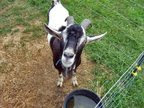Imported from New Zealand (they originally come from South Africa), Boer goat care is taking American goat raisers by storm. Reportedly, the breed is bringing out some of the more desirable features in goats (bulk, ease of care, meat quality, etc).
There are many other reasons, too, but the biggest could be that the Boers seem to be the hardiest among all the other breeds. Coupled with providing the most meat (and the tastiest, some would swear), Boers are also relatively easy to raise and care.
The Boers
Boer goats are large animals, generally white, with a red-brown head and long ears hanging down the sides of their faces. Males usually weigh between 200 to 350 pounds. The does can reach up to 200 pounds.
Boer goats resemble the Nubian, except for the size. Boers are large-framed and double-muscled, the leg bones and the whole bone structure bigger and thicker than the other breeds.
They have deep, broad chests, good back and strong shoulders, with heavy muscles in the rump. They are specifically raised for meat and they grow more rapidly and produce more muscling that other breed.
Why raise Boer goats
The breed is hardy, very adaptable and is easier to handle. Both the pure and the cross-breeds can survive on poor pasture that cannot support cattle.
Some ranchers use them for pasture management: they run these goats to clean up on the pasture lands after their cows.
The other reason for raising Boers is efficiency and space. Compared to cattle, the standard is one cow-calf pair for every acre of good pasture. It would be 6 does-two kids per acre for goats.
Comparisons on feeds for one cow and six goats would be great depending on the time of the year, pasture types, and regions. However, the big difference in sales would certainly make goat-raising, specifically the Boer breed a runaway winner.
Getting started
Buy your goats from reputable breeders rather than at stock yard auctions. Your Boer goats and your bucks, including cross-breeds should have papers.
Blood lines are not that important for buyers interested in goat meat, but the registration papers are your guarantee for being sure of your purchase. Besides, it is also for maintaining the resale value of your buck.
Keep a pedigree or a pedigree application with you before leaving with your animal. Ask questions. Take notes on their current disease control programs.
It pays to assess the condition of the whole herd from the farm where you bought your Boer. Check and see how the animals mature, if you are buying kids.
Make sure your breeder has a guarantee should your animal turn out to be a non-breeder. (This is a long shot, and happens very, very rarely.)
Other considerations
All over the world, goat meat is consumed by more than 80% of the total population. It could be that people already knew that goat meat has lower fat content than that of either lamb or beef.
In the United States, goat meat consumption is rising. One reason forwarded is that the improved meat flavor comes from the Boer variety. People claim Boer crossbreeds gives out mild and tender red goat meat.
Boer goat care, anyone?






No comments:
Post a Comment